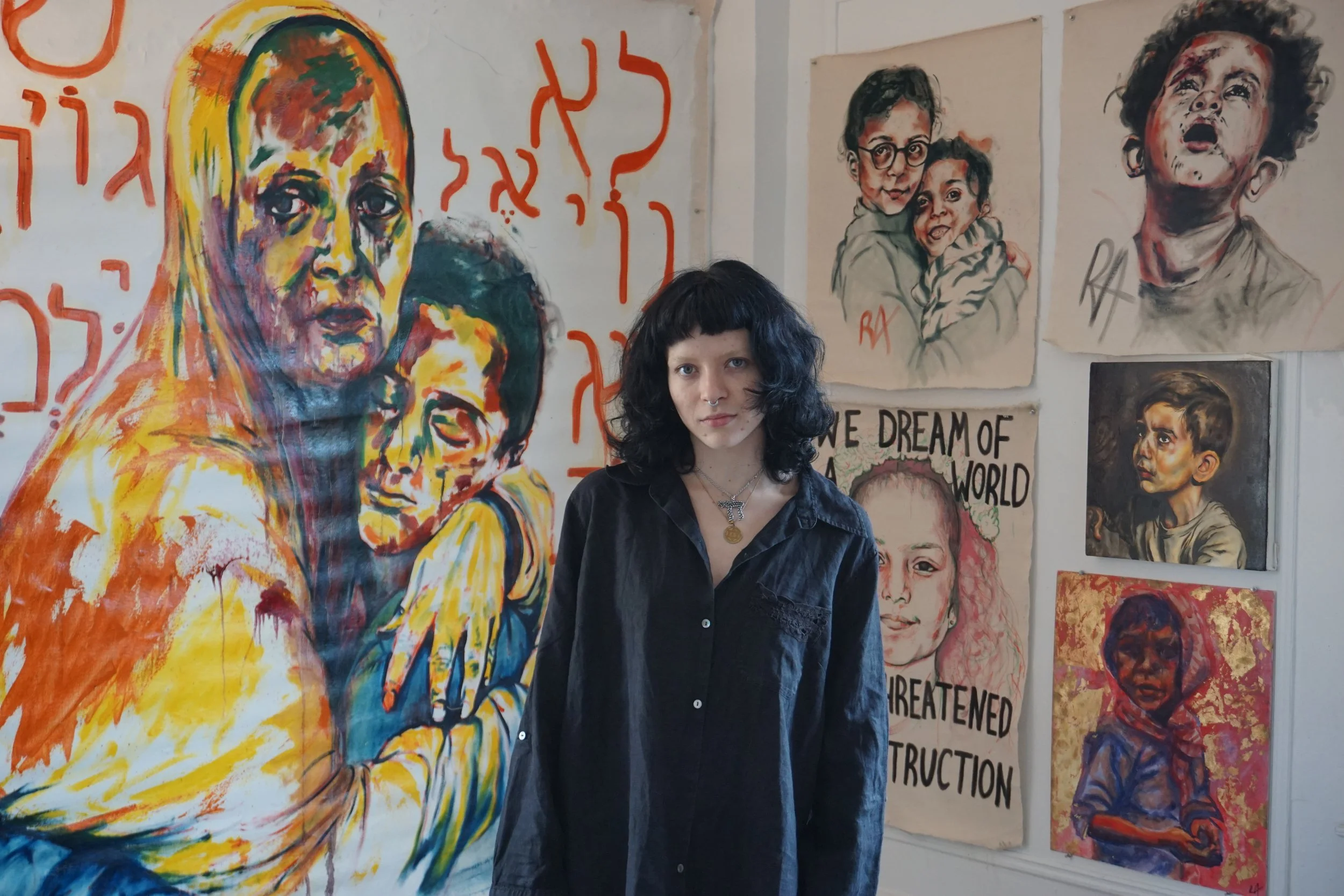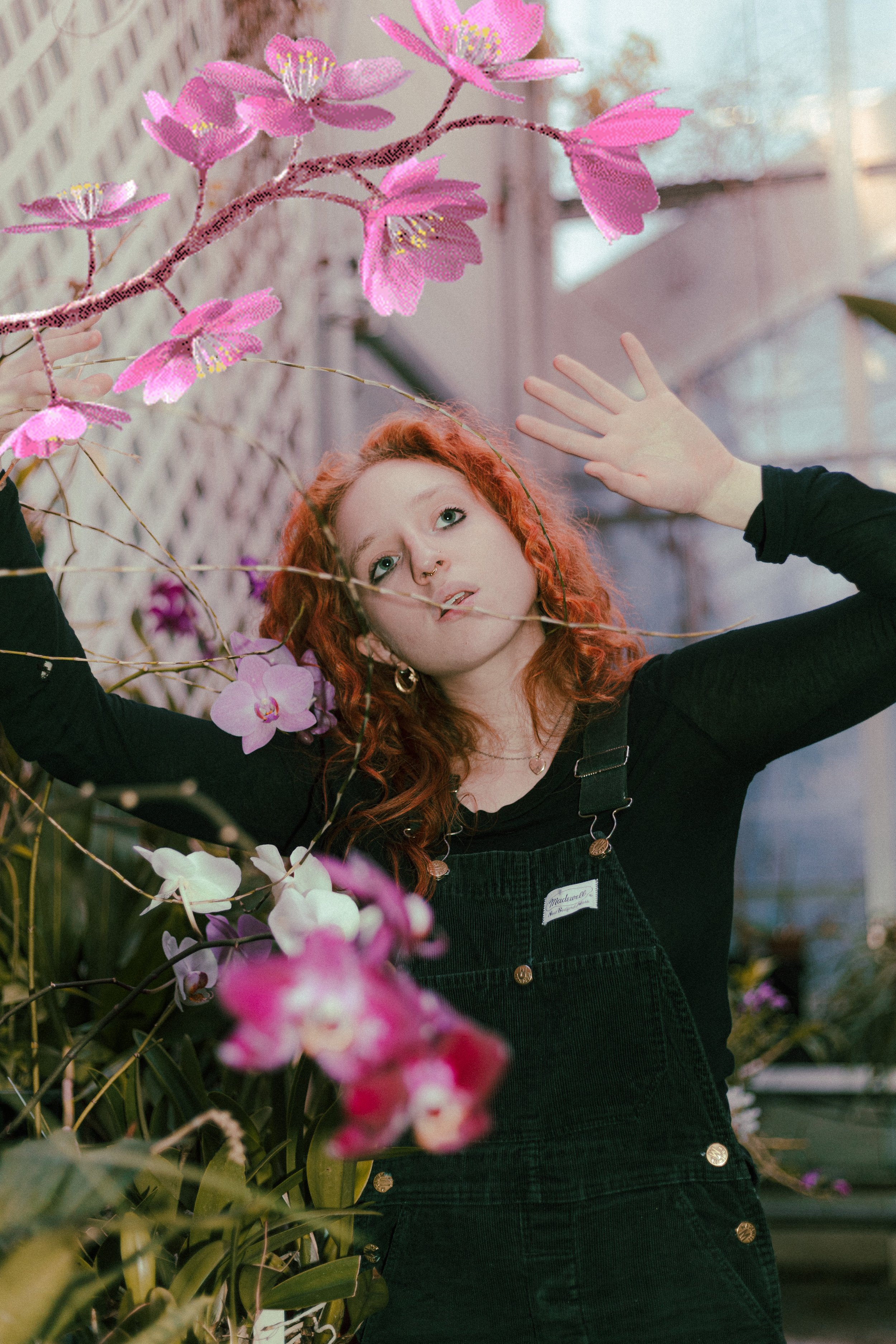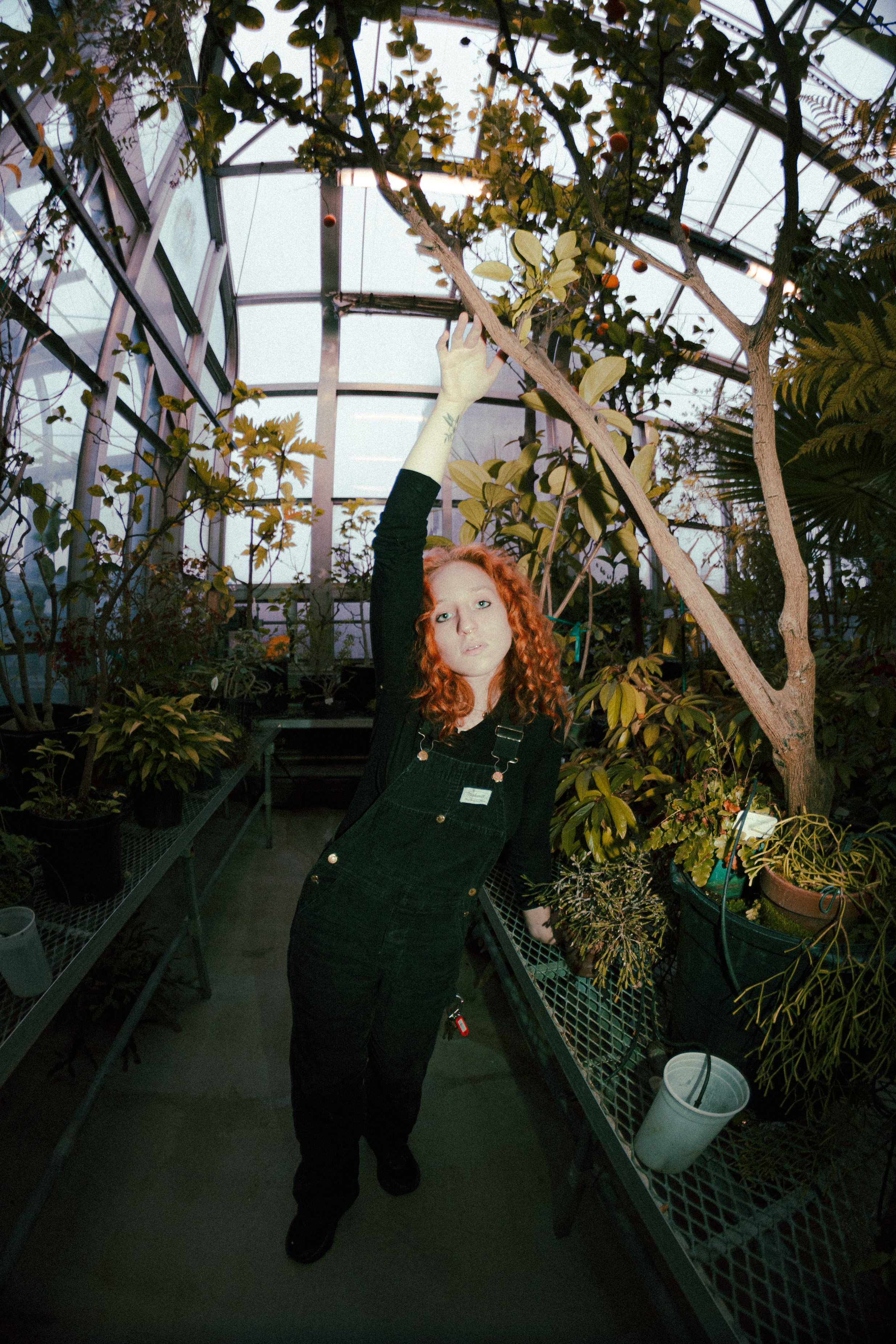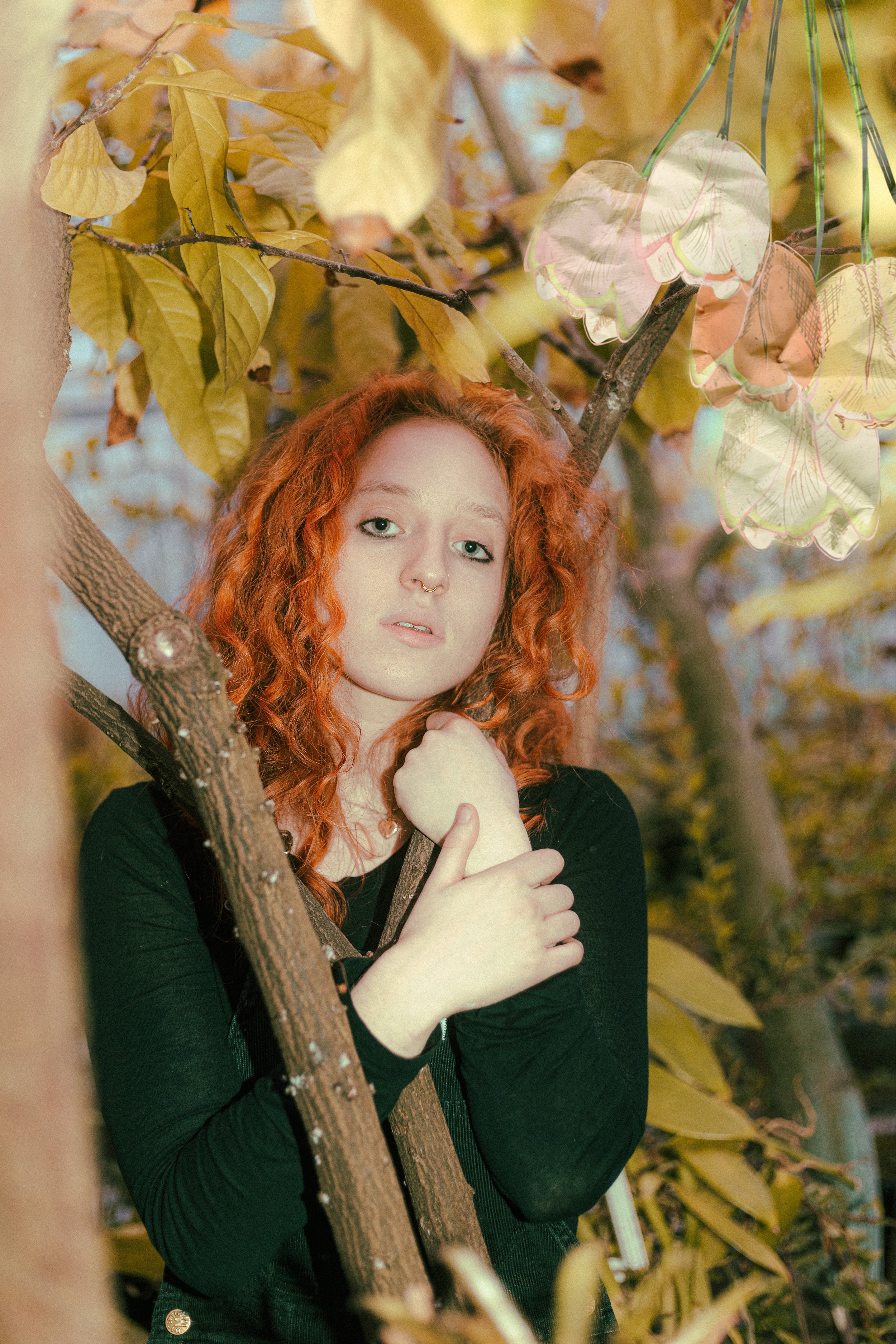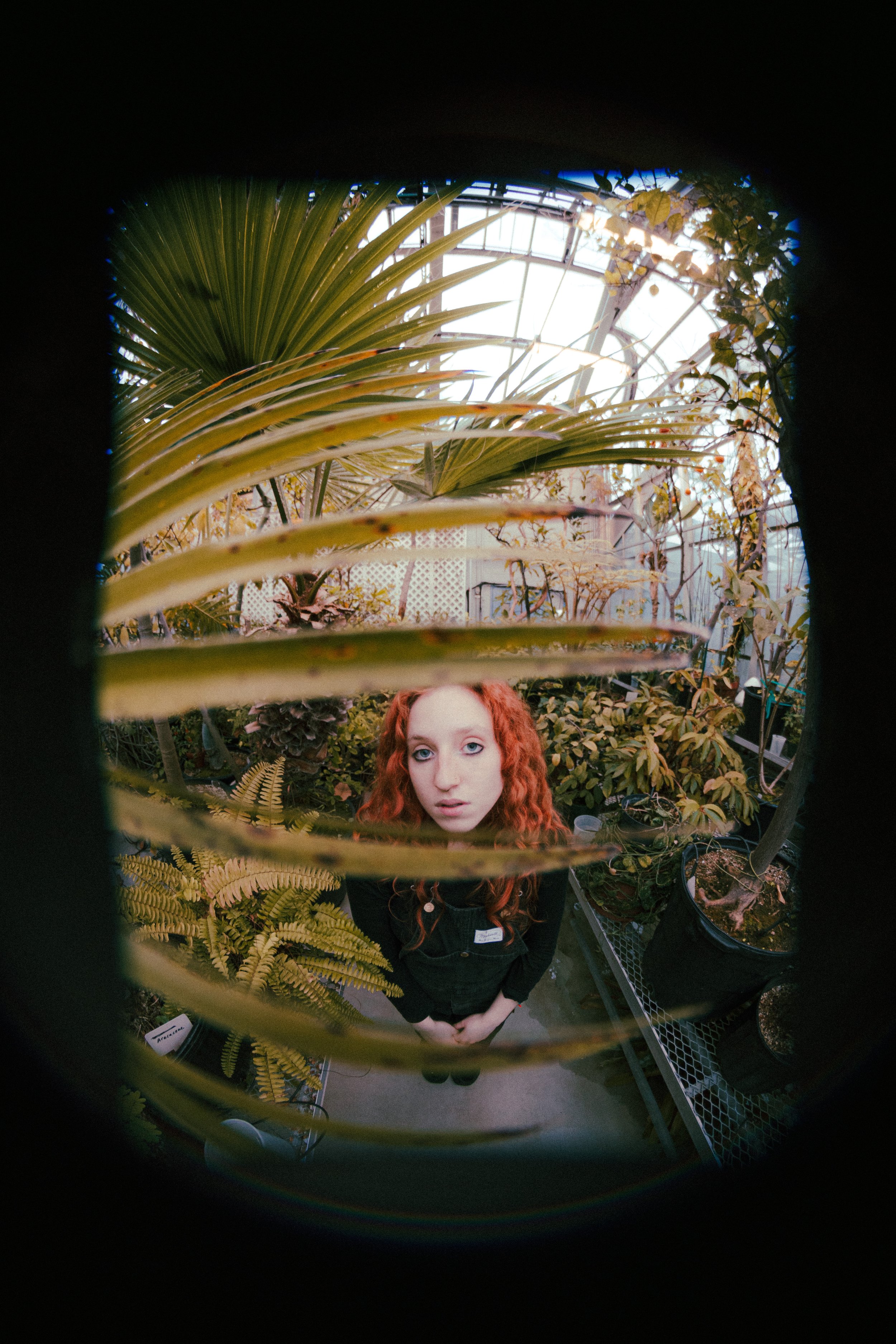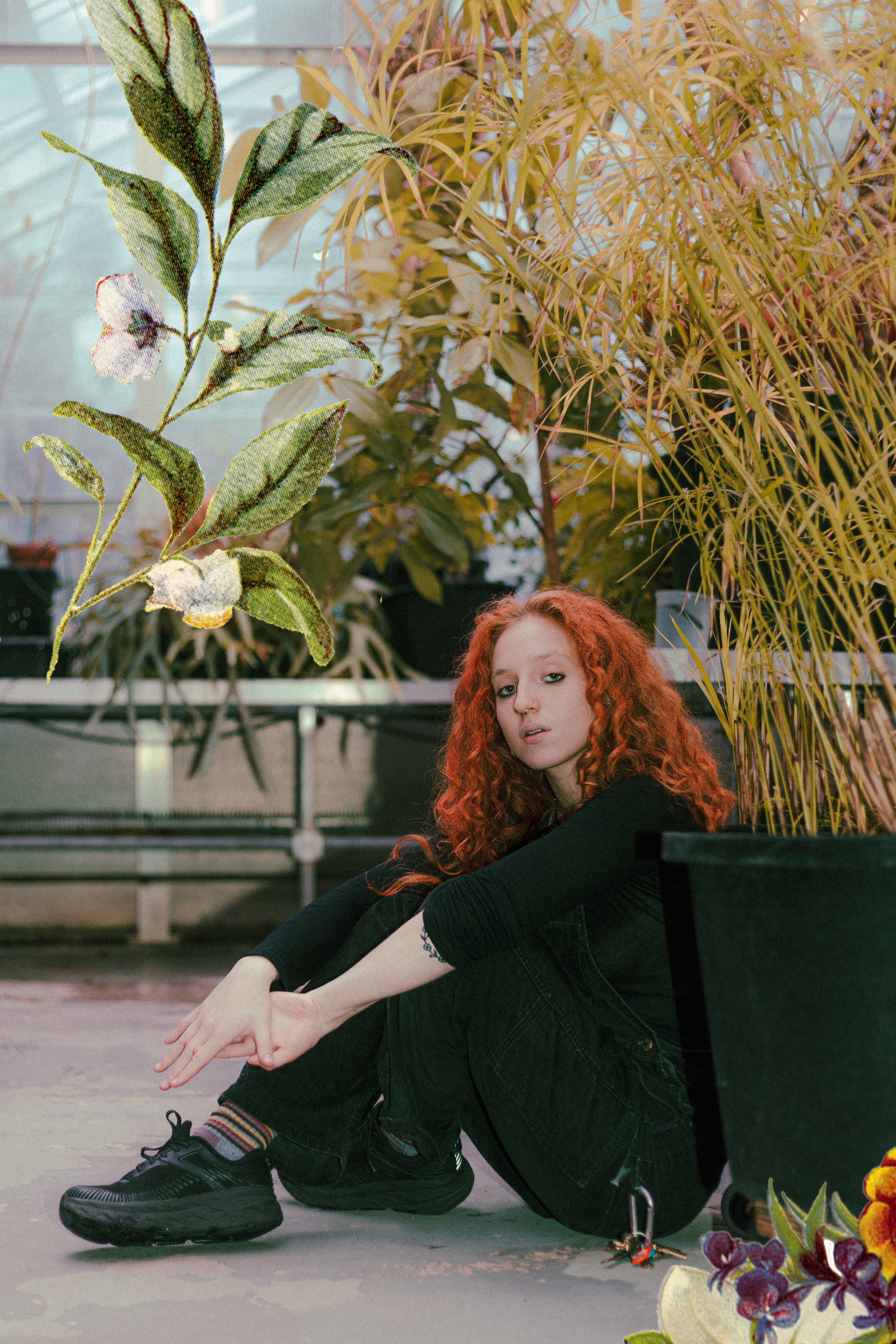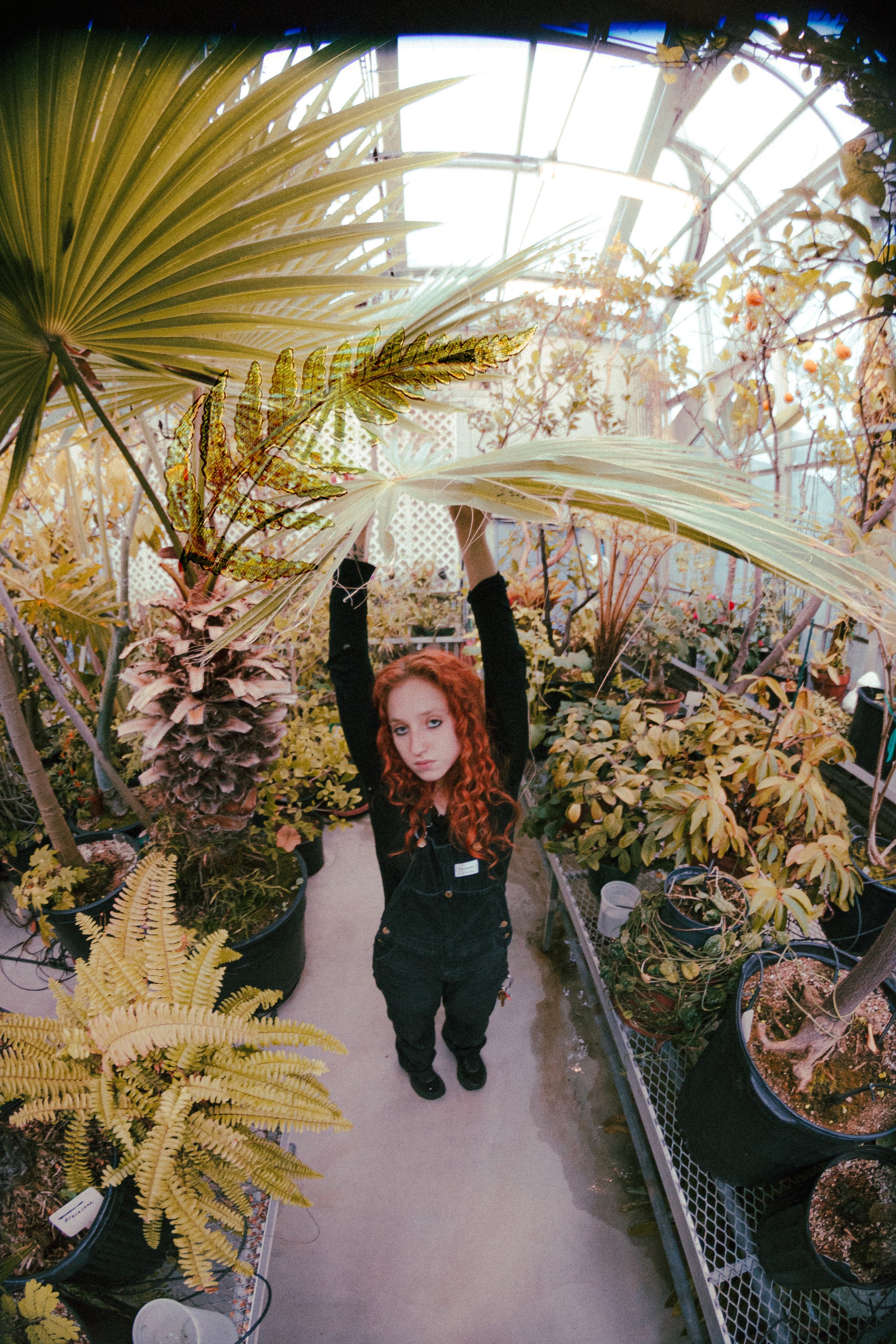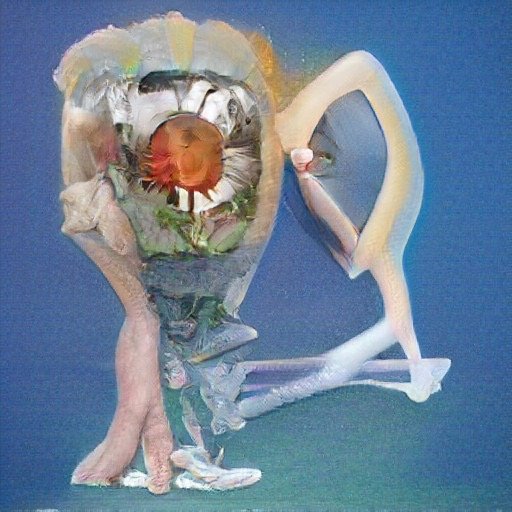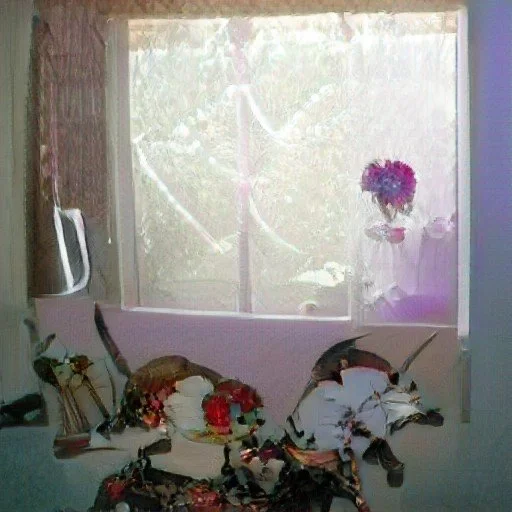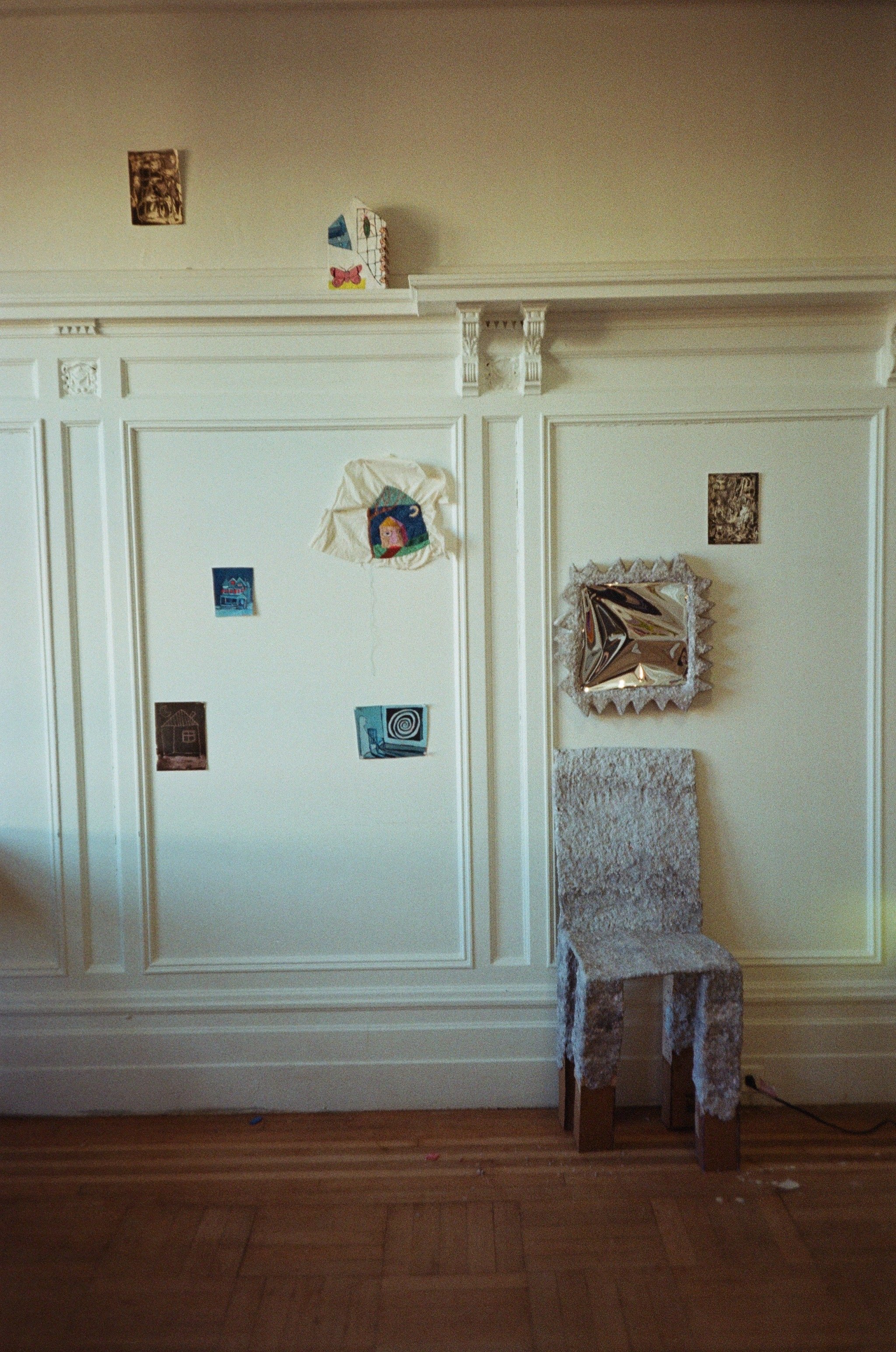Feature by Sophie Paquette
Photos by Jane Mok
Brooklyn-native Taylor Bluestine’s paintings, drawings, sculptures, and AI-generated images embrace surreality and chance. Materially motivated, Taylor plays with texture and touch until she finds her desired shapes, the strange forms which lend her work its precious delicacy. As she closes out her senior year at Barnard, Taylor boasts an impressive body of work operating across modes and scales, and her experimentation has only just begun.
Sophie:
A lot of your work pairs the domestic--frames, houses, bedrooms, chairs--with the dreamlike. How do these spaces interact in your art?
Taylor:
It's been a progression. Originally, I was doing this series that was very indexical. I started by making still lives and then deconstructing them, adding weird details and moments of color. It was like a painted collage. Some objects were domestic, some were natural. I would paint them pretty realistically and then construct backgrounds behind the images so it looked like they were cut from a piece of paper and collaged on the canvas, when in reality, it was one painting done cohesively. That was done using a lot of domestic materials.
Eventually, I got frustrated with that because I felt like everything was too fragmented, and I wanted to work on making whole compositions. That's where some of these more dreamlike works have come about, from that desire to not cut everything up and put it back together. Instead, I'm interested in how I can make something familiar, strange, and unique without having to disfigure it.
Sophie:
What you're saying about the implicit process of the painted collage reminds me of these hidden messages in your paper pulp. Could you talk more about making the paper pulp for the frames?
Taylor:
That's a medium that I really, really, really love. I've had an adventure with it. As an artist, if you work with a medium for a long time, you come to an intimate understanding of it. This is like four years of my practice coming to fruition.
I went to an arts-focused high school, and looking back, the projects were really sophisticated. We had a project doing embroidery, which you can see in my work now. We had projects where we had to create things from scratch, using cardboard, everything. We also had multiple projects with papier-mâché. That really influenced my approach to work and always wanting to dip my toes in new mediums.
When I started working with papier-mâché, I was like oh, cool, I wanna make some sort of sculptural thing. It was really frustrating at first. Nothing that I was doing came out right. They looked kind of like a kid's papier-mâché sculpture, very angular, which can be a cool and interesting look, but it wasn't getting to the level of sophistication that I wanted. So I also tried using plaster, but that failed horribly because the sculpture completely broke because it wasn’t sturdy enough.
I'd had this idea of using paper pulp on my radar for a while, but I was really intimidated by the process. One day I was like, you know what, I don't really understand how to do this, I don't really know what I'm doing, but I'm just gonna try because it can't be that hard. A lot of it was out of coincidence. My parents have a huge shredder in their room and they're always shredding documents. Every single bill they get in the mail, they shred. So I had this infinite supply of shredded paper that wasn't being used. I wasn't even thinking about the conceptual aspect, that came in later, but originally it was a material that was easily accessible. I started working with it, and I really fell in love with the materiality of it, and the way the inks on the paper dye the pulp when it's created.
Sophie:
It’s so interesting that the shredder comes from your parents' bedroom. Again, the work all feels very domestic. When did the paper pulp transition from just a material interest to a conceptual one? Do you consider the content of the pulp when you're making it, or do you rely more on play and chance?
Taylor:
I didn't realize the significance of it until I showed some of the work for the first time. I got a response from all these people being like, you're subverting use-value, et cetera. This is paper that has words on it, that's meant to communicate. And now it can't communicate anything. People wanted to know the process and the context, like where was I getting this from? What is it? It wasn't something that I had thought about because it was kind of obvious to me.
I love that the medium is super personal in that way. Every single batch you make is going to be different, and you don't really know what's in there. By nature, it's sensitive material, since it's shredded. So I don't really think too explicitly about the content. I am just happily surprised when I get some interesting papers that are in there and I get a really cool pulp. The one for that zigzag frame had blue credit cards in it, so it has this blue neppiness. What I'm working on now is a lot of shredded checks, which have this yellowy and speckled quality. So for the conceptual aspect, I really love that it has all these secrets, but I think it's almost more alluring that I don't know exactly what's in there. I'm arriving to it after it's already shredded.
Sophie:
When you show the frames, do you want the viewer to be aware of that process and where it came from, or do you prefer it to be this intimate or sensitive thing? Do you think the viewer's awareness of the material changes their interaction with the work?
Taylor:
I don't think that knowledge is necessary to engage with the work. I wouldn't be using the medium if I felt that, aesthetically, it wasn't successful on its own. I do think the concept adds an interesting underlay to everything in the sense that these are surreal images inside this kind of wacky frame. You can't really tell what the drawings mean and you can't really tell what the original paper means. It's just not that anymore. It’s just not what it was anymore. People get excited when they find out about the material. They think it has hidden meaning, which is funny because again, it was the result not so much of something that happened not as a conceptual decision but a material experiment development. So I'm torn, because I don't think it's necessary to know about the material, but at the same time, the reactions that I've gotten from other people emphasize how having that information made them see the work in a different light.
Sophie:
Do you ever record any kind of process documentation?
Taylor:
No, because when I'm working, my hands get actually disgusting. Like I'm a reptile with a second skin of glue. So I try not to touch anything.
Sophie:
The physical work all seems very manual. Aside from the frames or sculpture, even the graphite drawings have these tiny sketch marks, or you're working in embroidery or on very small pieces. As you move into AI-generated work and other digital work, do you feel that loss of tangibility?
Taylor:
I definitely do. These works don't really feel like they're mine in the same way. It feels like I'm a conduit or a curator. I'm the one pushing the button, generating them, and choosing which aspects to put together, so their existence wouldn't happen if it wasn't for me. But there's something about manual labor that is like, okay, I made this. Artists have definitely challenged this idea, and it's kind of a traditional mindset. But there's something about having a work that you made with your own hand, versus something that a computer made that you facilitated.
Sophie:
What's your process for your AI-generated works?
Taylor:
I use a website called Artbreeder. It's called Artbreeder because it literally analyzes images and then assigns "genes" to them based on a standardized image. Each image is created with these genes and you can cross-breed images that have different genes and get different results. A lot of the work is more curatorial because I generate like 300 or 400 images and then I go back and edit down to the ones that I really like. There are different formulas for AI generation that you can play around with, and you can go in and edit the genes of the images yourself. It’s weird and dystopian, but still fun to play around with.
Artbreeder is an interesting website because there's something skeevy about the name and the way it's having you factory-farm these images. But at the same time, the stuff you get is so precious. The moments and the colors. AI has such a unique and indistinguishable feel once you have an eye for it. There's nothing else that makes images like that and you can't really translate it. If you try to replicate it, it's not the same.
Sophie:
Displaying the AI-generated work, would those be on screens or would you print them out?
Taylor:
I've been struggling to figure out what medium to do those on because I had a studio visit and I was talking with Piper Marshall, who's curating the senior show, and she was talking about how frames act as a sort of protective element for these delicate graphite drawings. AI works are the opposite. If you’re familiar with Hito Steyerl, the AI works are like poor images. I've been thinking about putting them on fabric. I've been thinking about just projecting them. I don't know. I'm still thinking about that.
Sophie:
A lot of your work seems small scale, but you have these moments that push outward, like this big chair in the photo. Even within pieces, you manipulate the space of houses or bedrooms. What does size mean to you in your work?
Taylor:
A lot of artists are really obsessed with making really big things because of this conventionality we have that big work is more professional and sells better, or should be regarded as a higher form of art. I definitely bought into that for a long time. If I was painting, I thought it should be as big as possible. Then, I was doing an independent study with a professor who’s also the head of the art department at Barnard, Joan Snitzer. During Covid, we were working from home––I've always only really worked in my bedroom or at home. I think that's part of where the domestic stuff comes in as well.
Again, it's less of a conscious deliberation, but more about the environment that I'm in when I'm making these pieces. Joan assigned these really small works, and said to do them really quickly. If you look at the chair photo, those are the small works that are on the wall. And she was like, yeah, I don't even think you should make big works, here's your assignment: you're gonna make 300 small paintings. So I made 300 small paintings. Once you start working on a scale that's easily transportable and that you can work on anywhere, like comfortably in bed, it's hard to go back to wanting to do huge ambitious stuff.
Sophie:
You work in so many modes. Are there any materials you'd like to try?
Taylor:
I was looking into learning how to do stained glass, like ornaments or hanging stuff.
Sophie:
That makes a lot of sense. There is a light that comes through all of your work, like the drawings or the AI. They are all sort of glowy.
Taylor:
But again, I get kind of psyched out by starting with new materials. The initial commitment, ordering the kit and starting something, sometimes can feel daunting. Which is funny because I'm always doing it.
Sophie:
Where else can we find your work?
Taylor:
I post my work on my instagram @ddddeathmetal. I also have a website.




